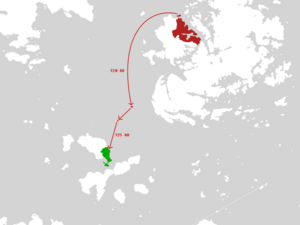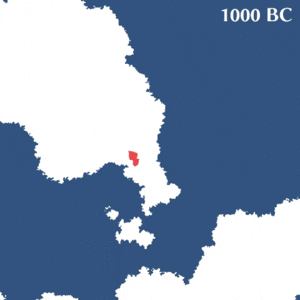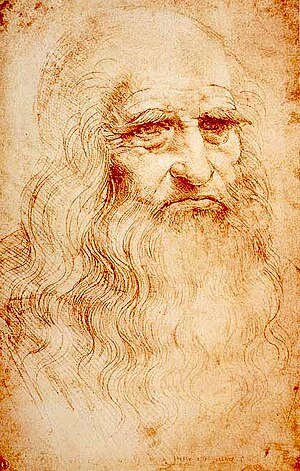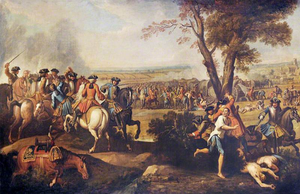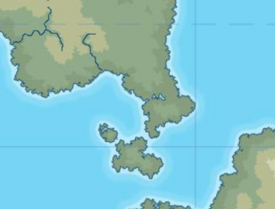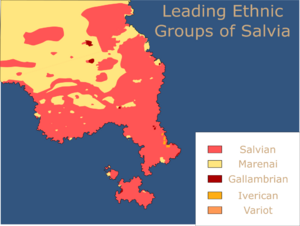Sanctum Imperium Catholicum
The Divine Republic of the Holy Catholic Empire Tapinus Remporu dox Sanctum Imperium Catholicum | |
|---|---|
|
Flag | |
Motto: "Through the Trinity, We Flourish" | |
 Physical map of Salvia and major cities | |
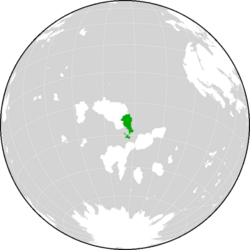 Location of Salvia in Marenesia | |
| Status | Independent State |
| Capital and largest city | Deopolis |
| Official languages | Salvian, Aroman |
| Ethnic groups |
|
| Religion | Salvian Catholicism |
| Demonym(s) | Salvian |
| Government | Constitutional Federal Republic |
• President | President Patrick Saulius |
| Legislature | Concilio Populi, Concilio Clerici |
| Establishment | |
| 743 BC | |
| 505 BC | |
| 247 AD | |
| 605 AD | |
| 1261 AD | |
| 1709 AD | |
| Area | |
• Total | 201,509 km2 (77,803 sq mi) |
| Population | |
• 2016 census | 23,001,900 |
| GDP (nominal) | estimate |
• Total | $895,000,000,000 |
• Per capita | $38,910 |
| HDI (2018) | .876 very high |
| Currency | Salvian Croinare (SCR) |
| Time zone | UTC+3 |
| Date format | dd/mm/yyyy |
| Driving side | right |
| Calling code | +301 |
| Internet TLD | .sic |
Salvia, officially called the Divine Republic of the Sanctum Imperium Catholicum (Salvian: Tapinus Remporu dox Sanctum Imperium Catholicum; Aroman: Respublica Divina Sancti Imperi Catholici), is a constitutional federal republic located in Marenesia Major. The nation borders Alvernia and the Bay of Salvae to the west, Tanemum to the north, the South Oriental Sea to the east and the Straits of Sicani to the south. The Sanctum Imperium Catholicum covers 201,509 square kilometers and has has an estimated population of 23 million. Salvia comprises of 12 provinces on the mainland and 3 additional overseas territories which were former colonies. It’s capital and largest city is Deopolis.
First home to early hunter-gatherers that originated from the Europan continent 50 kya, southern Europans arrived in modern day Salvia as early as 25,000 years ago and experienced a genetic admixture with the first Marenesians, creating the Euro-Marenai people that inhabit Marenesia to this day. Evidence of agriculture can be found as first appearing around 5000 BC, while the first permanent settlements in Salvia can be dated back to around 4000 BC. Dozens of tribes existed in ancient Salvia and almost all had some influence on the culture of the Friulian tribe, which only emerged by around 1450 BC. The Friulian tribe would go on to conquer neighboring tribes, and by 600 BC had declared the creation of the First Salvian Imperium. The name "Salvia" as a name for the region was first used by the Friulians to describe their empire as their borders encapsulated dozens of native tribes. The following golden age produced by the peace would lead to the emergence of a distinct Salvian culture. The First Salvian Imperium enjoyed around 4 centuries of relative prosperity and growth before the arrival of Aroman migrants in what historians have dubbed the Great Aroman Migration. The Aroman migrants brought disease: this, combined with a series of poor harvests and other natural disasters, would lead to the complete collapse of the First Imperium in 175 AD. A Christian Second Imperium was formed in 247 AD. The peninsula experienced 4 centuries of relative economic prosperity and cultural progress under the new Christian dynasty. A coup d'etat in 605 AD removed the Christian government and a pagan military general took full power. Lasting only 80 years, the collapse of the short-lived Third Salvian Imperium marked the beginning of the medieval era in Salvia.
Salvia has started to emerge from isolation that was a result of the Great Alharun War and economic hardships experienced after; the Salvian government negotiated international trade deals with several nations, including Andalla and Tagmatium, and joined the intercontinental defense organization known as Tricontinental Defence Treaty Organisation. On 3 March 2020, Cardinal Matteo Selva Lorenzo of Alvernia was elected to the papacy, taking the name Pope Gregory XVII and becoming the Salvian head of state.
Etymology
The name derives from the Salvian words for the “Divine Republic of the Holy Catholic Empire”. This references its its foundation as a Catholic empire and now republican government. The name is sometimes shortened to its acronym, “SIC", but is most commonly called "Salvia" after the name of the first united empires in the region, the Salvian Imperiums. The official name was first adopted by King Joseph I when he christened his newly united kingdom as the Sanctum Salvae Imperium Catholicum following his coronation by the reigning pope, Pope Leo VI. This was then changed to Tapinus Remporu dox Sanctum Imperium Catholicum in 1709 following the conclusion of the People's War.
The origins of the name "Salvia" are disputed, however the most popular held theory by historians is that it originates from the native Friulian word for "country", "territory", or "region". The term Salvia now refers to the country of The Sanctum Imperium Catholicum, however can also be used as a word for the general region that includes The Sanctum Imperium Catholicum and extends beyond it. Use of the term "Salvia" outside of the Sanctum Imperium Catholicum is mostly made by Salvian nationalists wishing to unite all Salvian peoples, most notably in Alvernia.
History
Prehistory (before 11th century BC)
Pre-Antiquity (11th century-6th century)

Pre-Friulian Salvia was host to a myriad of native peoples and tribes, although little is known about them due to the First Imperium's suppression of rival cultures which followed their conquests. Existing evidence and research indicates that these tribes predated the Friulians by some time and were of Euro-Marenai descent, similar to ancient Friulians. This has led historians to conclude that the Friulian tribe was a branch of another tribe, potentially the nearby Beritrians.
The ancient Friulians, orignially located in modern day Bergarmium in southwest Salvia, were landlocked for the early part of the history before expanding and subjugating their neighbors. Incorporating much of the southwestern coastline into their territory by around 743 BC, the ancient Friulians then engaged in trade, and Friulian goods can be found as far as Adlantic islands and southern Europa. Despite their cultural similarities, Friulians considered their culture superior and so forcefully culturally integrated those they subjugated. This perceived superiority led to the destruction of many cultural artifacts of the other tribes of Salvia, although some of these cultures were preserved through ancient manuscripts and writings.
Early Antiquity (7th century BC-2nd century AD)
The First Salvian Imperium was characterized by its frequent aggression and expansion as well as its vast trading empire that was expanded throughout its history. With their advanced knowledge in sailing, Salvian traders were able to reach as far north as the Occident. This trade made the empire incredibly wealthy throughout its history as well as encouraged advances in philosophy, mathematics, science, and art due to contact with the Occident civilizations, most notably the Aroman Empire.
The First Salvian Imperium was officially declared by High Emperor Volano I in 650 BC and was the continuation of the Kingdom of Friulia.

The Salvian Empire conquered their neighboring tribes and nations; the Minetites and Alavonians to the north, the Rassutians along the eastern coast, and the Olanians to the south were all subjugated as early as 473 BC. More territory was annexed after the Salvian Wars of Expansion, extending the empire beyond the peninsula. Trade continued to flourish as the Imperium became incredibly wealthy off of their natural resources, mainly their agricultural goods grown in the south. The conclusion of the Salvian Wars of Expansion in 89 BC would usher in the age of Pax Salvae, or "Salvian Peace" which would last until the arrival of Liosous in 125 AD. The period was marked by a time of great economic and cultural prosperity. At its greatest extent, the Salvian Empire included the peninsula, stretched from the Adisi Ocean to the South Oriental Ocean and was as far north as modern day northern Tanemum.
The First Imperium fell after the beginning of a civil war following the introduction of the new Christian religion, which was introduced in the first half of the century by a prophet named Liosous from Tagmatium, and a large drop in population following the arrival of migrants from the Aroman Empire and diseases foreign to the native Salvians.
The Salvian Imperium was among the most powerful economic, cultural, political and military forces in Marenesia during the time and its borders extended beyond modern day Salvia. The Salvian Imperium's legacy has greatly impacted the Sanctum Imperium Catholicum, and by extension, regions under current or former control of Salvia. While not nearly as influential as the Aroman Empire on the world stage, the legacy of the Salvian Imperium influenced the Salvian region and surrounding area greatly. Classical Salvian works and knowledge would inspire the Late Medieval Renaissance and the Magnum Progressum a millennia later.
Great Aroman Migration (2nd century AD)
The arrival of Aroman migrants following the prophet and apostle Liosous would be dubbed by historians as the Great Aroman Migration. This migration was not a singlular event but rather a wave of 6-8 migrations (accounts and primary sources vary on the number) in which thousands of people sailed from the Aroman Empire to Marenesia. The migration and subsequent consequences are usually credited for the collapse of the First Salvian Imperium, the radical change of Salvian culture and society, and the introduction and eventual dominance of Christianity in Salvia and beyond. The event is marked by most historians as the single most important event in Salvian history.
First arriving in 125 AD, the Aroman migrants arrived in the northeastern part of the empire. The government of the Imperium, under the Emperor Iseo Tanemahuta, was largely indifferent to the first wave of migrants, which comprised of the prophet Liosous and a band of several hundred followers. While the official religion of the state was an animistic pagan faith with the emperor at the center, Liosous was allowed to preach and Christians were given special protection after two of the emperor's sons, Princes Teo and Kei, were baptized and converted to Christianity. Without the leadership of Liosous, who was working on establishing a Christian community in the capital, Ziologiana, the Aroman band would soon clash with the native Salvians. These conflicts, combined with the spread of Aroman diseases the migrants brought over that proved especially fatal, would seriously sour relations between the native Salvians and Aromans. War broke out in 156 AD, shortly after the death of Liosous. By this time, two more waves of Aroman migrants had arrived, and the simultaneous rise of the Aroman population and sudden drop of the native Salvian population meant the war ended in a stalemate. Following the Peace of Demetaen in 160 AD, the two sides made peace and after a series of poor harvests, natural disasters, and a socioeconomic crisis as a result of the rapid decline in population the First Imperium would collapse in 173 AD.
A second genetic admixing would occur as several new waves of Aromans interbred with the recovering Salvian population. While ethnic conflicts occurred, they were rare as the native Salvian population sought to recover. The Aromanswere incorporated into the native Salvian populace as many rose to the top of the social and economic ladder due to their extensive experiences and knowledge carried over from the Aroman Empire. This integration would have a resounding impact felt today, with many distinct physical features of the modern Salvian, most notably the white skin, originating from the genetic admixing. The Aroman culture and introduction of Christianity would also prove momentous in the history and culture of Salvia. It would eventually be a Aromannoble to found the Second Salvian Imperium.
Late Antiquity (2nd century-7th century)
Following the collapse of the First Imperium, numerous chieftains and nobles rose to power and attempted to impose their rule on Salvia. The Christian north, largely composed of the Aroman migrants, had formed the province of Proculmea, a colony of the Aroman Empire. The colony, joining forces with the Alvernians, were able to consolidate power in the north and were united following the royal marriage between the king of Proculmea, King John II, and Princess Aroha of Alvernia in 217 AD. The marriage formed the Zaoutzes dynasty which would lead the Second Imperium for its entire 400-year history. Following the union, the two powers held control over much of the former First Imperium's northern territory. Further conquests would lead to the annexation of territory as far south as Lake Caperthia, reaching its largest extent by 419 AD.
The Second Imperium established a vast trading network similar to the First. Salvian goods exchanged with islanders, southern Europans, and neighboring Marenesians made the empire very prosperous and developed. Many of the kings focused on building internal infrastructure which became much of the foundation for future highways, roads, and waterways. The economic prosperity that the empire experienced allowed for the development of science and art, and this time period oversaw the introduction and development of the first Salvian-Christian art, a style that greatly influenced medieval Salvian art. Some of the oldest churches in Salvia were also built across the Second Imperium's territory, and the domination of the Second Imperium in the northern region of the peninsula cemented the region as solidly Christian, resulting in the Salvian peninsula being divided for a further 600 years as pagan and Christians battled for supremacy. While not as expansive as the First Imperium, many contemporary historians argue that the Second Imperium was very influential in regards to establishing Christian roots in Salvia, as well as fostering a prosperous economic trading empire that later Salvian nations, including the Sanctum Imperium Catholicum, followed.
After 400 years of rule, the Christian dynasty of the Second Imperium was overthrown following a coup d'etat by a pagan general, Makate Nomehana, in 605 AD. Nomehana sought to reintroduce Salvian paganism as the main religion, but faced harsh resistance and revolts in the Christian north after attempting to tear down Christian churches. After quelling the revolts, Nomehana reversed his policies and allowed for the practice of Christianity while also encouraging Salvian paganism through taxation or funding of pagan temples. Nomehana annexed the rest of the Salvian peninsula and the Sicani Islands, but otherwise led an isolationist foreign policy, ending trade with outside nations. Makate would be succeeded by his son, Alene Nomehana, following his death in 632. This isolationist policy, which resulted in an economic collapse, and the Nomehanan dynasty's own unpopularity would lead to the Third Imperium's downfall shortly after the beginning of the reign of Alene's daughter, Kamakani, in 685 AD. The collapse was violent and divisive, and resulted in the Salvian peninsula becoming incredibly fractured, something which persisted for the next 600 years. The collapse of the Third Imperium is marked by most contemporary historians as the beginning of the medieval period in Salvia.
Early Medieval Period (7th century-12th century)
The beginning of the medieval period in Salvia, while debated by historians, is most commonly marked as starting with the fall of the short-lived Third Imperium in 689 AD and the rise of the medieval kingdoms that took its place. Several large kingdoms - most notably the Demetaens, Alvernians, Lavittans, and the Samoricans - dominated the former territory of the previous Imperiums, while numerous petty kingdoms and free cities also populated the coasts. Many of these kingdoms, to include the larger ones, no longer identified by tribe as pre-Antiquity, but instead had a shared "Salvian" culture that linked them together. This shared culture, though, was contrasted by political, religious, and economic differences that would lead the kingdoms into a constant power struggle. The numerous kingdoms, domains, and free cities would be divided for 600 years.

With the baptism of King Clovidian I in 701 AD, the Kingdom of Lavitta had embraced Christianity; this would propagate its spread and turn it from a large minority religion that prevailed in the north to the majority religion in Salvia - it's estimated that around 55% of the Salvian population was Christian and would be around 70% by the 12th century. Paganism was still prevalent within the Republic of Demetae, especially along the west coast, while numerous heretical movements threatened Christian unity.
The sudden collapse of the Third Imperium left Salvians without clear direction or a leader. Many port cities declared themselves independent while barons and lords of large tracts of land declared their own petty kingdoms. Some would consolidate power and carve out their own territory, with most of these petty kingdoms lasting only a few decades before being absorbed into larger domains. With the weakened and divided state of the Salvian kingdoms, early medieval Salvian history saw a great spike of northern highland and pirate raids until the 12th century. This time period also saw the emergence of feudalism as the dominant form of class structure throughout Salvia. The rapid decentralization of Salvia meant that the landed aristocracy and nobility found themselves without protection from an overarching government - this would lead to the hiring of mercenaries for protection and would eventually evolve into the medieval knight.
By 800 AD, the west coast of the peninsula and the Sicani Islands had become incorporated in the Demetaen Republic, a loose confederation that exhibited major influence over its neighbors, especially in the south by Lake Caperthia. Extensive mercantile operations were carried out by the Demetaen Republic, which would only increase with the subjugating of port cities on the southern island that granted the Demetaens access to valuable natural resources, including precious metals. The Lavittans and Samorcians began to carve their own kingdoms in the north and on the east coast; the south coast was largely divided into numerous dominions and petty kingdoms that resisted incorporation into the more powerful Lavittan and Demetaen powers. The Alvernian Kingdom, significantly weakened following the fall of the Second Imperium, suffered raids and attacks from both the Demetaens and native Marenai from the Agrillian Highlands, crippling the kingdom further. Following invasions by the Demetaens and Lavittans, the Alvernian Kingdom would collapse in 1017 AD, however the entire Alvernian Kingdom was not subjugated by the invading forces - petty kingdoms were established along the western coast and a large section of the north was mostly ruled by Agrillian highlander clans.
The turn of the 12th century saw the numerous free cities and petty kingdoms of the south form the Confederation of Rassena, thus creating four major powers on the Salvian peninsula. A century of peace would follow the formation of the Confederation as the Demetaens and Samoricans recognized the futility in attacking the southern confederation. However, conflict would soon erupt between the four powers in the late 1100s as the Kingdom of Lavitta, under the Gaullis dynasty, was able to centralize power under the monarch and so were powerful enough to challenge the other states of the peninsula, who remained divided.
Late Medieval Period (12th century-15th century)
First emerging as the kings of Lattiva in the 10th century, the Gaullis dynasty progressively centralized power and expanded the kingdom farther north, subduing many of the barbarians that had raided the kingdom since the 7th century. Later kings would expand the scope of royal authority and slowly centralized the kingdom; during this process, the kingdom centered on a hierarchical society distinguishing nobility, clergy, and commoners. The Lattivans would initiate the Wars of the Four Kingdoms, alternatively known as the Lattivan Wars of Conquest, which were a series of wars that took place from 1204 to 1261. The Gaullis dynasty of the Kingdom of Lattiva succeeded in establishing control over most of Samorica after the decisive Battle of Sotania, and the Kingdom of Samorica would fall by 1227. Between 1225 and 1241, the Lattivans also pursued the annexation of the Confederation of Rassena through dynastic warfare, intermarriages, and diplomatic missions. The last vestige of the Confederation in the Free City of Novalen would be annexed after the decisive Battle of Cotalan in late 1241.
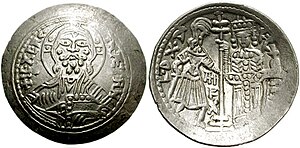
War with the Demetaens was long and drawn out; competent Demetaen command led to Lattivan defeats and the expansive trade they conducted meant they were able to afford capable and powerful standing armies. The Demetaens also made use of the terrain as natural defenses: the Agrio River, Agrillian Highlands, and Lake Caperthia all proved difficult places to stage an assault, and the Lattivans had already weakened themselves with the conquests of the Samoricans and Rassenans. An uneasy peace between the two sides was declared in 1240. The death of King Leo II in 1256 led to his son, Joseph Gaullis, becoming King Joseph Gaullis I of Lattiva. Joseph I, considered to be a brilliant tactician, would conquer the Demetaens by summer 1260, following the fall of the capital, Eytchs. The remaining forces of the Republic disbanded and surrendered to the Lavittans and Joseph Gaullis returned home to Lavitta to declare the reformation of the Salvian Empire, this time christening it the Sanctum Salvae Imperium Catholicum, or Holy Salvian Catholic Empire. To further his legitimacy, he was coronated by Pope Leo VI as King Joseph I of Salvia. Joseph began work on converting the remaining pagans of Salvia by expanding the scope of the Catholic Church. Both the Church and the state also began work on rebuilding their conquered territories and swiftly brought the areas back to their pre-war prosperity. The Gaullis dynasty would begin to centralize power, reaching the height of its medieval power by the rule of King Luvertan I. The absence of political conflict meant this power and prosperity would be retained by Salvian kings until the 16th century.
(Crusades?)
Following the unification of Salvia, trade with southern Europa and Adlantic territories was further expanded. The increase in trade would facilitate the spread of $$$$, which would kill half of Salvia's 11 million people, resulting in dramatic social, political, and economic changes.
Early Modern Period (15th century-18th century)
The Magnum Progressum, or "Great Progression," was a period of great cultural and scientific progression fueled by the patronage of the Salvian Church and kings. Art, literature, architecture, and philosophical thought flourished. The development of humanist thought, while at first stifled by the Church, was soon accepted as humanists became heavily inspired by Church teachings. There were, however, several humanists who broke off from the Church and would influence secular, Enlightenment thinking, most notably Eugene de la Rose.
The Great Progression oversaw the emergence of a new artistic style in the form of the Progressive art style. A distinguishing characteristic of Progressive art that separated it from medieval styles was its focus on realistic, linear perspective. The development of such a perspective, pioneered by artists Giottus Alberti and Leonardus del Fyre, demonstrated a trend towards realism. The new art style was heavily influenced by Salvian classical works, an increased interest and development of mathematics, and new painting techniques developed by artists.
The expansive trading empires the Salvians had established under previous empires and kingdoms began to expand on an unseen scale as improvements in sailing technology and the adaptation of Europan techniques meant that the distance a ship could sail in one trip increased dramatically. The proto-capitalist trading empire that had been expanded and utilized the most by the Republic of Demetae was expanded in both size and scope. The establishment of joint-stock companies and the government's pursuit of mercantilist policies led to the development of modern capitalism in Salvia. The prosperity of traders and bankers who profited from this system combined with the price revolution resulted in the growth of the urban petite and upper bourgeoisie class. While the bourgeoisie had been present in Salvia in some form since the 11th century, the 15th-17th century would see the largest growth of its size and prosperity until the Industrial Revolution.
Extensive trade, the desires for future profit, and a motivation to spread Salvian Catholicism were all contributing factors for the 16th century Crusades and establishment of colonies. Colonial holdings and trading ports were established throughout the New World, further profiting the Salvian empire. In the mid 16th century, Popes Gregory IX and Hilarius XVI declared a crusade on the expanding Yellow Empire, which had threatened Christian kingdoms and Salvian colonies in Alharu. Two other minor crusades would be called during this time period, both on the Palu Peninsula: the Lycean Crusade, and the Metzli Crusade.
The return of the victorious crusaders proved a challenge to King Gaetno II. Rebellions in the northern regions of the empire proved difficult to suppress as barons and lords in Salvia continued to subtly resist his rule. The Analgian League, a military and economic alliance between numerous lords of the north and along the eastern coast, was formed in 1549 as a political bloc that opposed Gaetno's attempts at centralizing power. The returning crusaders, now with popularity, experienced troops, and riches gained from the crusades, joined the League and began a war with Gaetno in 1559, starting the War of the Analgian League. Led by Lord Flavio Burgellio, the opposing forces would capture Gaetno and a majority of his force in the Battle of Milvia in 1563, and Gaetno promptly abdicated in favor of Burgellio, ending Gaullis rule in Salvia. After establishing the two Concilios in 1569, Burgellio would die in 1570, and was succeeded by his son, Leo. While Burgellio himself oversaw attempts at decentralization, his successors continued Gaetno's work of centralization and were considered absolutist monarchs. This centralization would create tensions with the nobility, while high taxes in the late 1600s set to fund costly wars and expeditions angered much of the middle and lower classes. By the beginning of the 18th century, the monarch had become increasingly unpopular.
Revolutionary Salvia and the 18th century (1707-1802)
The tensions between the monarch, the nobility, and the middle class were carried over to the 18th century and worsened by King Peter III. Further taxation, illegal evocation of the powers of the Concilios, and continued centralization and oppression all led to protests throughout Salvia starting in early 1707. Governors of provinces began forming the United Provinces, a confederation of provinces that opposed the monarch. After protesters in Trinity were shot in the Trinity Massacre, the United Provinces declared a state of official revolt and began the People's War. Despite outnumbering the monarchists, democratic forces would struggle with poor command, supplies, and weaponry, extending the war for two years before declaring victory following the capture of Deopolis on 1 June, 1709. The Treaty of Trinity would formally end the war on 12 July, 1709. The war would also inspire nationalist movements in Alvernia and Tanemum, leading to their declarations of independence following the conclusion of the war.
Several notable thinkers and philosophers of the time joined the democrats and would become the cornerstone of their movement: these included lawyer Leo Angelo and governor Jacob Bern, both of which are considered founders of Salvian democracy and would go on to become presidents following the war's conclusion. Other noted thinkers such as Carlo Ranzini would author the Salvian Constitution, which sought to guarantee the rights and liberties of the people and the Concilio Populi and created the judicial branch. It officially removed the monarchy and reduced the power of the Church by making the Concilio Clerici subversive to the Concilio Populi and confiscating some Church property. To appease the Church and the devout peasantry, the Pope was made a figurehead of the new republic, a position he still holds today.
While at first restricted to upper class Catholic males, the reforms of President Bergio Valla would expand suffrage to almost all Catholic males by the end of the 1760s. The Salvian republic retained its overseas territories, confiscating them from the crown and placing them in the control of the newly created executive branch. Despite the success and stability of the new government throughout the 18th century, Salvia still saw its overall power and wealth fall as the loss of Alvernia and Tanemum set back the Salvian economy. The new republic, relatively stable and beneficial to the growing middle class, would see new methods of production in the so-called "cottage industry". Considered a form of proto-Industrialization, the growth of the system would eventually lead to the Industrial Revolution in Salvia.
In 1718, the government officially adopted the new name of "The Divine Republic of the Sanctum Salvae Imperium Catholicum", which is the official name of the country today.
Industrial Era (late 18th century-19th century)
Advancements in technology and trade with Europan nations brought the Industrial Revolution to Salvia. Heavy industrialization occurred throughout the 19th century and built off of the cottage industry that was developed throughout the nation in the 18th century. Industrial centers grew primarily in the northwest, with cities such as Minotia and Alonia growing significantly in population. Industrialization, along with successive governments encouraging laissez-faire policies and free trade, led to an explosion in Salvian output and a rapidly growing economy and middle class. To secure larger markets and resources for growing industries, the Salvian state reaffirmed their grip on their New Wurld colonies, sparking the $$$$-Salvian rivalry which was largely based on conflicts arising over colonies. The Salvian colonial empire was expanded to include $$$$.
Largely unchecked by the government throughout the early 19th century, industrialization and the poor condition of workers gave rise to socialist movements, which saw success in the later half of the 19th century in the form of the Salvian Christian Worker Movement. The SCWM pushed for numerous labor reform laws that protected Salvian workers and successfully lobbied the Concilios for reform. These laws were limited to the industrializing north as agriculture continued to dominate the southern economy, with southern estate owners bribing officials to ignore violations of labor laws. By 1910, laws specifically protecting agricultural workers were passed and began to be enforced. Political power shifted away from the landed, southern elite and towards northern industrialists. Further reform laws began to transfer power in the Concilio Populi from the landed elite to the middle class, a trend that continued throughout the century. With male suffrage fully granted in 1831, urban workers and agricultural laborers began to vote in liberal governments such as the Salvian Christian Worker Party, a party based on the SCWM, by the 1850s. Starting the Salvian Age of Reform (1851-1919), a period of liberal reforms that benefited lower to middle class laborers and workers, the SCWP would hold power in the Concilio Populi for over 60 years. Other laws further reduced the political power of the Church, instead refocusing it as an educator and welfare provider.
(Marenesian Events - creation of Gallambria and how it interacts with Salvia)
Contemporary Salvia (20th century-present)
Notes- International affairs- treaties Domestic affairs- oil and inflation crisis (potentially), women suffrage
Geography
Salvia is a relatively flat nation, save for the Agrilian Highlands to the west and the coastal flatlands.
The nation is also abundant in rivers and has a couple of natural occurring lakes, the most notable being Lake Caperthia to the south.
The country lies in Marenesia Major.
Climate
WIP: DFA and CSA
Flora and Fauna
WIP
Politics and Government
The Sanctum Imperium Catholicum has been a unitary semi-presidential representative republic since 1709 after the People's War. The Pope of the Salvian Catholic Church, currently Pope Gregory XVII since 2020, is the Salvian head of state. The President of Salvia, currently President Patrick Saulius since 2016, is the Salvian head of government and is elected every 5 years by eligible voters. The Vice President of Salvia runs on the same ticket as the president and is the second-highest officer in the executive branch.
Government
Salvia has a representative government based on a mixed proportional and majoritarian voting system. The Salvian government is comprised of three branches: the legislative, the executive, and the judicial.
The parliament, known as the Convention of Houses, is a bicameral legislature comprising of the Concilio Populi, with $$$ members, and the Concilio Clerici, with 106 members; both meet at Alexis Hall in Deopolis. The Vice President is known as the President of the Convention of the Houses and presides over any sessions of the Concilio Populi, having the power to cast a vote in favor for or against a measure if he wishes too. The Concilio Populi wields considerably more power than the Concilio Clerici, as dictated by the 1709 Constitution of Salvia: for example, it may, at the discretion of the President, dismiss the Concilio Clerici for a set period of time. Any bill proposed by the Concilio Clerici must be approved by the Concilio Populi by at least three-fifths majority; this same rule does not apply to the Concilio Populi. Concilio Populi representatives are elected to represent their local constituents and serve 4 year terms and have a term limit of 5 terms. Delegates of the Concilio Clerici are appointed by regional Castuses for 6 year terms and have a term limit of 2 terms.
The president is the leader of the Executive Branch and holds effective executive power; he is also the head of the Executive Council, which consists of all 18 ministers and department heads who are appointed by the president, and the apostolic nuncio to Salvia, which is appointed by the Salvian pope. The President may enact most executive functions without approval from either Concilio or the Executive Council, although he may be impeached by two-thirds vote from both Concilios and the Executive Council if found guilty of "incompetence, treason, or other crimes against the state." Aside from his responsibilities in the Concilio Populi, the Vice President is considered the President's successor upon death, removal from office, or retirement.
Despite being the head of state, the Salvian pope has relatively few powers and is largely a figurehead. Similar to the Vice President, the Salvian pope may cast a vote in favor for or against a measure in the Concilio Clerici and has the ability to appoint the regional Castuses.
Regionally,
As of 2016, national voter turnout was estimated at 71%.
Executive Branch
The nation as a whole is led by the President of the Sanctum Imperium Catholicum, and is elected through popular vote. The position is held for one term lasting 5 years, and can be elected for 3 terms. The powers and responsibilities of the president include:
- Uphold the laws of the nation,
- Appoint federal positions,
- Sign treaties and pieces of legislation, and
- Sign executive orders
The president is President Patrick Saulius, who formerly served as both president and Archbishop of Minotia and Catholic Aslonia before being defrocked pro gratia. The vice president is Seamus Finley.
Legislative Branch
The Convention of Houses is made up by the Concilio Populi (Council of the People) and Concilio Clerici (Council of the Clergy). Both houses have elected representatives, although the qualifications as well as the actual process is notably different.
The Concilio Populi is the larger and more important branch of the Convention, with 230 representatives each having 6 year terms. However, the House is not all elected at once; half of the representatives are under election every three years. The elections every three years are also not at the same time - they usually span throughout the whole year, however the elections are scheduled by the regional council. Representatives are proportionally elected provincially, with each representative having to earn a minimum of 55,000 votes to win a seat. Representatives have a 2 term limit. Single transferable vote is used for the candidates that do not make 55,000. The current Speaker of the House is Michael Pokorney.
The Concilio Clerici is a somewhat elected, smaller, and more select group of 115 representatives. These representatives are approved by a regional council and the regional Castus instead of being directly elected, and serve for shorter 4 year terms with a 2 term limit. The representatives are members of the clergy, usually priests, nuns, or brothers. All and any bills proposed by the Concilio Clerici must be approved by the Concilio Populi by at least three-fifths majority; this same rule does not apply to the Concilio Populi. The current Speaker of the Clergy is Monsignor Justin Erin.
Law
Salvia uses a combined civil and common legal system, where law is primarily derived from legal documents to be interpreted by judges.
Foreign Relations
WIP
Military
WIP
Economy
The economy of Salvia is classified as a developed capitalist social market economy. Its major economic factors are tourism, electronic manufacturing, shipbuilding, agriculture, textiles, and lumber production. Salvia is regarded as one of the world's most industrialized nations and a leading country in world trade and exports. Salvia is one of the world's largest manufacturing country, characterized by a smaller number of global multinational corporations than other economies of comparable size. Most of Salvia's industrial capacity is clustered in the north,
Economic Sectors
Agriculture
WIP
Tourism
The Divine Imperium contains many popular cultural and historical sites, home to millions of tourists each year. Thus, a thriving industry in tourism was born, raking in billions of Salvian Crosses for both private industry and the government. Some popular religious, cultural, or historical sites might include St. Murphy's Cathedral, Museum and Palace (6.2 million annual visitors), Chauteu-del-Monte (large country house of the del-Monte royal house, 1.8 million), Gerizim Hill (supposed location of the prophet Liosous' burial, 1.7 million), and Spiritu Sancti, the most famous cathedral in the nation (1.5 million).
Textiles
Ship Manufacturing
WIP
Electronics Manufacturing
External Trade
With many trade deals with other nations, the Sanctum Imperium Catholicum and has been trading goods surplus for a profit for decades. Its main exports are electronics, lumber, and foodstuffs, of which wine and fruit, specifically cirtus, make up most foodstuff exports. Salvia has extensive trade deals with nations outside of Marenesia, and is currently expanding its reach with deals with Tagmatium and Andalla.
Infrastructure
The Sanctum Imperium Catholicum is a highly developed nation, even in the rural regions. The nation is connected through both the Murway National Highway System as well as by trains and other public transport. Public transport in the nation is both privately and nationally funded, making it one of the best in the region. Railroads and highways connect major cities, with each city containing a hub where both railroads and highways span out of. Major hubs are located in the nation’s largest 5 cities, and the system as a whole contains a network of both short-distance and long-distance rail lines and roads running from it to nearby urban areas and other hubs.
Many citizens have access to the internet, and cell phone ownership is high. Internet speeds vary although the nation is very technologically developed.
Around 23 airports exist in Salvia, most of them local airfields in rural and suburban areas. There are 2 major international airports that connect Salvia with the outside world, and are used for both the movement of people and goods. Privately owned airlines dominant the scene, and the nationally owned Salvian Ways is small and usually only used for government officials.
Salvia has 5 deep water seaports, which are home to the majority of the nation’s exports and imports. These economic hubs are also the sites of much of the shipbuilding industry.
Demographics
Population
The Sanctum Imperium Catholicum has a population of 23,001,900 people, of which an estimated 50,000 are undocumented illegal immigrants. The average fertility rate is 3.8 children, and the average life expectancy is 82.4 years: 81.3 for men and 83.5 for women. Most of the population is concentrated along the coasts and in the northwest urban center of Minotia. Approximately 73% of the population lives in urban areas.
| Rank | Name | Region | Pop. | Rank | Name | Region | Pop. | ||
|---|---|---|---|---|---|---|---|---|---|
 Deopolis  Trinity |
1 | Deopolis | Deopolis | 4,232,198 | 11 | Selavake | Ascloni | 441,745 |  St. Mark's  St. Paul's |
| 2 | Trinity | Ascloni | 1,932,789 | 12 | Bergarmia | Bergarmium | 372,683 | ||
| 3 | St. Mark's | Lattimo | 1,307,129 | 13 | Domube | Lavazza | 387,263 | ||
| 4 | St. Paul's | Rassena | 1,105,657 | 14 | Trescia | Bretana | 330,102 | ||
| 5 | Minotia | Occidentali | 1,007,343 | 15 | Port Liosus | Port Liosus | 315,890 | ||
| 6 | Columma | Lavazza | 849,874 | 16 | Urbano | Bretana | 303,172 | ||
| 7 | Pianna | Occidentali | 704,599 | 17 | Sondresia | Ascloni | 299,467 | ||
| 8 | Leana | Bergarmium | 530,024 | 18 | Rohetania | Canahiti | 248,901 | ||
| 9 | Alonia | Occidentali | 485,244 | 19 | Montenan | Port Liosus | 239,852 | ||
| 10 | Isea | Bergarmium | 453,219 | 20 | Sedala | Bretana | 209,603 | ||
Language
The Constitution of 1709 made both Salvian, a romance language dervied from Aroman, and Aroman the official languages of the country. While very few people are fluent in Aroman and nobody speaks in the vernacular, all state documents on the federal and provincial level must be written in Salvian and Aroman.
The typical dialect of the Imperium is Salvian, with an estimated 99% of the population speaking it. However, a notable chunk of that percentage (37%) is bilingual, typically in Batengdeian or another language.
Religion
Since the foundation of the Second Imperium, the nation has been largely Salvian Catholic. This holds up even in modern times, with around 91% of the population falling under the Catholic faith according to the 2017 national census. The rest of the population is filled with a diverse set of religions.
Although religious freedoms have been held up in modern times, national distrust of certain religions, especially those who practice Judaism and Islam, is especially prevalent in the western conservative regions. The region has a history of attacks on people of both faiths, although none have been encouraged by the Church or government in modern times.
Ethnic groups
Most Salvians are themselves ethnically Salvians - around 86%, or 19,780,000 people, identified as "solely Salvian" on the 2016 official census. However, this statistic is considered inaccurate by some, as ethnically mixed Salvian-Marenai are widely considered to be Salvian and identify as such. Despite this tendency, Salvian-Marenai individuals may self-report as "solely Marenai" or biracial if they choose to. Different regions reflect their different regional heritage, which can date as far back as Pre-antiquity. Culturally, regional variations are most distinct between the north and the south.
The Marenai are the second largest ethnic group of Salvia, comprising of 9%, or around 2.07 million people. They make up the ethnic majority in several northwestern counties and occasionally in the south. Other ethnic minorities include Gallambrians, Ivericans, and Variot, yet the number of Tagmatines are swiftly rising and are expected to overtake the Variot populace by 2021. Following the Cussian Humanitarian Crisis and the intake of Cussian refugees by the Salvian government, Cussians now comprise another minority in Salvia.
Ethnic tensions between Salvians and Marenai were once widespread, yet became rare in the early modern era. They often existed along religious tensions, with Catholic Salvians in conflict with Marenai pagans. In contrast, ethnic tensions are observable in Alvernia as elements of systematic oppression remain.
Culture
Almost every aspect of Salvian life is influenced by Salvian Catholicism and native Marenai, Aroman, and southern Europan traditions. Salvian culture is marked by strong historic ties to Catholicism, which played a pivotal role in the country's formation and subsequent identity. Its art, literature, and national identity is also based off of native Salvian practices, beliefs, and characteristics that defined the people before the Great Aroman Migration and introduction of Aroman and Christian traditions. Salvian culture is considered by many as a hybrid between the local Marenai culture, which sees influence from southern Europa, classical Aroman, and traditional Catholicism.
Influences
Native Marenai
Aroman
Salvian Catholicism
Architecture
Arts and Literature
After the Magnum Progressum, the arts and literature flourished, which brought upon much of the works that modern Salvians admire today. Film and literature are the most popular among the masses, although other arts, such as paintings, dances, and operas, remain popular. Many works of art and literature contain religious underlying themes. The Church, under popes during the Magnum Progressum, heavily promoted the arts and literature through funding and contract work.
The country has a small but active film industry.
Cuisine
Food is very diverse in Salvia, with the cuisine stressing the importance of taste. Fruit is served as dessert due to its sweet nature and Salvia's extensive production of it. Wine is also very popular during meals and dessert, and the southeastern region is the nation’s leading producer of wine.
Some popular dishes include:
WIP
Sports and Hobbies
The most popular sports in Salvia are rugby and football (soccer). Both sports each have their own leagues (RSA and FA, respectively) and both sports have their own national team that compete internationally. Other popular sports includes swimming, boxing, and wrestling. The typical Salvian will play a sport throughout their schooling career. Many people also have other hobbies, which can be as mundane as reading and watching films to the extremes of skydiving and everything in between. Typical hobbies include reading, astronomy, and athletics such as sports, although it is hard to pin down a definite answer due to the sheer amount of them. Although uncommon, it is not very rare to see Salvians spend much of their free time with religion, especially through prayer or religious education at home and abroad. Religion has influenced Salvian culture since before the introduction of Christianity.

